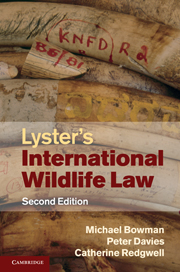Book contents
- Frontmatter
- Contents
- Foreword
- Preface
- List of abbreviations
- PART I Foundations of international wildlife law
- PART II Species regulation
- PART III Regional wildlife regulation
- 8 The Convention on Nature Protection and Wildlife Preservation in the Western Hemisphere
- 9 The African Convention on the Conservation of Nature and Natural Resources
- 10 The Convention on the Conservation of European Wildlife and Natural Habitats
- 11 Polar regions
- 12 Other regional and subregional arrangements
- PART IV Global wildlife regulation
- PART V Biological diversity: a new perspective on wildlife regulation
- PART VI Cross-sectoral issues in wildlife regulation
- PART VII Conclusion
- Index
- References
11 - Polar regions
Published online by Cambridge University Press: 05 July 2011
- Frontmatter
- Contents
- Foreword
- Preface
- List of abbreviations
- PART I Foundations of international wildlife law
- PART II Species regulation
- PART III Regional wildlife regulation
- 8 The Convention on Nature Protection and Wildlife Preservation in the Western Hemisphere
- 9 The African Convention on the Conservation of Nature and Natural Resources
- 10 The Convention on the Conservation of European Wildlife and Natural Habitats
- 11 Polar regions
- 12 Other regional and subregional arrangements
- PART IV Global wildlife regulation
- PART V Biological diversity: a new perspective on wildlife regulation
- PART VI Cross-sectoral issues in wildlife regulation
- PART VII Conclusion
- Index
- References
Summary
Introduction
Both the Arctic and Antarctic polar regions are subject to regional rules for, inter alia, the protection of species and of habitat. While special rules exist for other regions, as for example explored in the other chapters in Part III of this book, the polar regions are different by virtue of ‘their size compared to other regions, the unique problems they face, the interest of the whole international community in their management and resource potential, and the means that have been adopted to deal with management problems’. Additionally, while other areas may be more severely affected by climate change, its impact on polar bear habitat, and the consequences for sea-level rise of the melting of ‘permanent’ Antarctic ice shelves, have had catalytic effect upon perceptions of this global problem. The polar regions are considered key to our general understanding of climate change. In 2009, the first ever (largely symbolic) Joint Ministerial Meeting of the Antarctic Treaty/Arctic Council took place in Washington on 6 April 2009 on the occasion of the conclusion of the fourth International Polar Year (2007–8) and the fiftieth anniversary of the Antarctic Treaty.
Yet there are also significant differences between them. Geographically, the Arctic comprises an ocean surrounded by continental land masses, while the Antarctic is a continent surrounded by ocean. Arctic peoples have inhabited the northern polar region for thousands of years, while Antarctica has no permanent population save for scientists.
- Type
- Chapter
- Information
- Lyster's International Wildlife Law , pp. 346 - 375Publisher: Cambridge University PressPrint publication year: 2010
References
- 1
- Cited by



